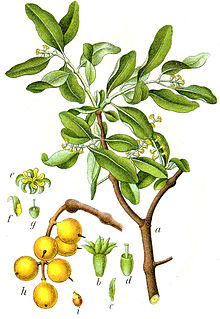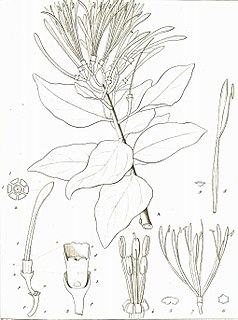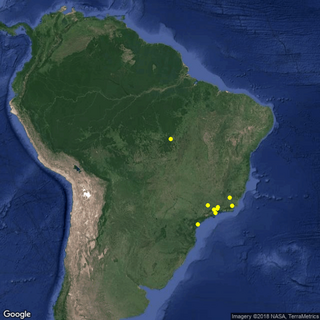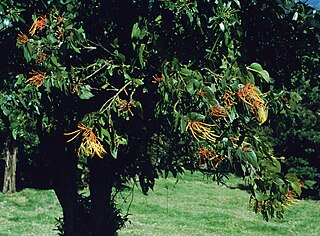George Don was a Scottish botanist and plant collector.

Loranthus is a genus of parasitic plants that grow on the branches of woody trees. It belongs to the family Loranthaceae, the showy mistletoe family. In most earlier systematic treatments it contains all mistletoe species with bisexual flowers, though some species have reversed to unisexual flowers. Other treatments restrict the genus to a few species. The systematic situation of Loranthus is not entirely clear.

Dipteryx charapilla is a little-known species of legume in the family Fabaceae, a large to mid-sized tree growing along rivers in the rainforests of Brazil and Peru.

Psittacanthus, also parrot-flower, is a plant genus in the family Loranthaceae. It is a type of mistletoe native from central Mexico southwards to Central America and parts of South America.

Symphyotrichum lateriflorum is a species of flowering plant of the aster family (Asteraceae) native to eastern and central North America. Commonly known as calico aster, starved aster, and white woodland aster, it is a perennial, herbaceous plant that may reach 120 cm (47 in) high and 30 cm (12 in) across. With composite flowers, each flower head has many tiny florets put together into what appears as one, as do all plants in the family Asteraceae.

Crepidium, commonly known as 沼兰属 or spur orchids is a genus of about three hundred species of orchids in the family Orchidaceae. Plants in this genus are evergreen, mostly terrestrial plants with short stems lying on the ground, two or more relatively large, pleated leaves and small, non-resupinate flowers with spreading sepals and petals. The genus is widely distributed in the tropics.

Dysoxylum rufum is a rainforest tree in the family Meliaceae, found in eastern Australia. It occurs on a variety of different soils and rainforest types. From as far south as Bulahdelah, New South Wales to the McIlwraith Range in far north eastern Australia. The specific epithet rufum refers to the rusty red of the leaf, fruit and flower hairs of this species.

Acacia prominens is a shrub or tree in the genus Acacia native to New South Wales, Australia.

Psittacanthus robustus is a species of Neotropical mistletoe in the family Loranthaceae, which is found in Brazil, Colombia, Guyana, and Venezuela.

Psittacanthus calyculatus,, is a species of Neotropical mistletoe in the family Loranthaceae, native to Colombia, Mexico, the Mexican Gulf, and Venezuela.

Psittacanthus brasiliensis is a species of Neotropical mistletoe in the family Loranthaceae, which is endemic to Brazil.

Psittacanthus schiedeanus G.Don is a species of Neotropical mistletoe in the family Loranthaceae, which is native to Panamá, Costa Rica, Honduras and Mexico.

Psittacanthus acinarius is a species of mistletoe in the family Loranthaceae, which is native to Bolivia, Brazil, Colombia, Costa Rica, Ecuador, Peru, Venezuela, and French Guiana.
Psittacanthus biternatus is a species of mistletoe in the family Loranthaceae, which is native to Brazil, Venezuela, and Colombia.

Hypericum przewalskii, commonly called Przewalski's St. John's wort, is a flowering plant in Hypericumsect. Roscyna that is native to China.
Phreatia micrantha, commonly known as the native fan orchid, is a plant in the orchid family and is an epiphyte or lithophyte with four to ten channelled leaves in a fan-like arrangement with their bases sheathing the stem. A large number of small white, cup-shaped flowers are arranged along a thin, wiry flowering stem. This orchid is native to areas between Papuasia and the western Pacific.

Psittacanthus cucullaris is a species of mistletoe in the family Loranthaceae, and is native to Costa Rica, Bolivia, Colombia, Ecuador, French Guiana, Peru, Suriname, Venezuela and Brazil.
Amyema pliculata is a species of hemi-parasitic shrub found in the Bismarck Archipelago, New Guinea, New South Wales and Queensland.

Anchietea is a genus of flowering plants in the violet family Violaceae, with six accepted species, found in tropical South America.
Carpolobia is a genus of plants in the milkwort family (Polygalaceae) that are native to Tropical Africa and Madagascar. It was first written about in 1831 by George Don, at which point 4 species were identified. In 1849, the number of accepted species went down to 2. The other 2 became part of the legume family. The 2 species that remained, alba and lutea, were described as closely resembling each other. It was initially in the Polygaleae tribe before being split off in 1992 along with the genus Atroxima to form the new tribe of Carpolobieae.















